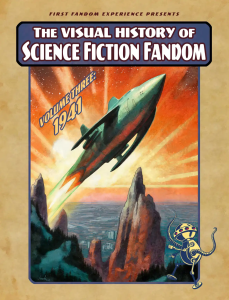Gary K. Wolfe Reviews The Visual History of Science Fiction Fandom, Volume Three: 1941 by David Ritter, Daniel Ritter, Sam McDonald, & John L. Coker III
 The Visual History of Science Fiction Fandom, Volume Three: 1941, David Ritter, Daniel Ritter, Sam McDonald, & John L. Coker III (First Fandom Experience 978-1-73665-965-6, $149.00, 504pp, hc) April 2024.
The Visual History of Science Fiction Fandom, Volume Three: 1941, David Ritter, Daniel Ritter, Sam McDonald, & John L. Coker III (First Fandom Experience 978-1-73665-965-6, $149.00, 504pp, hc) April 2024.
If someone were to tell me that a lavish 500-page coffee-table book selling for $149 is basically a microhistory describing what a bunch of people I’ve mostly never heard of were doing in 1941, I’d quite reasonably be skeptical; the very idea sounds like an oxymoron, in the same way that Sam Moskowitz titled his own memoir The Immortal Storm, as though trying to turn the infighting of a motley group of teenage SF fans into the Iliad. But that’s exactly how I’m describing The Visual History of Science Fiction Fandom, Volume Three: 1941, the latest archeological dig from the collective known as the First Fandom Experience, mostly David and Daniel Ritter. As they note in the preface, the original plan was to publish one volume covering the 1930s, culminating in the first Worldcon in 1939, and a second covering the 1940s. But the wealth of material, coming from private collections as well as university archives, was such that volume two covered only 1940, and now volume three is entirely devoted to 1941.
As with the first two volumes, the glossy pages are filled with color reproductions, mostly of fading fanzines (a few enhanced to make them more legible), along with many photos, meticulously researched interpretive text to place everything in context, and a few special features such as original graphic narratives illustrating some of the more dramatic episodes of 1940 fandom. And, as before, the cast of characters is overwhelmingly white, male, and young, and even readers somewhat familiar with old-time fannish history are likely to encounter a level of granular detail they’ve never seen before; this is really an effort, as the collective’s name suggests, to recreate for the reader a sense of what it must have been like to be a devoted fan in 1940. The book opens with an apparent fistfight that led to the demise of the Queens Science Fiction Society, which had battled the Futurians over the 1939 Worldcon. Later, more than 20 pages are devoted to the saga of Earl Singleton, an urbane fellow who gathered a sort of following at the 1940 Chicon, and whose reported suicide in early 1941 turned out to be a hoax (he was apparently just trying to get out of fandom, and who can blame him?) Another long sequence traces the career of Arthur Louis Joquel III, who produced some 20 innovative fanzine issues in 1940 alone. We learn of Martha Sleeper, a minor Hollywood actor who created a line of Martian-inspired costume jewelry that briefly became popular with fans. We get a typewritten outline of Heinlein’s first draft of a future history, and a foreboding sense as various fans report their classification under the newly instituted military draft. But except for names like Heinlein, Bradbury, Campbell, and Clarke (there are some unnerving bits describing British fandom trying to hold itself together during the Blitz), there isn’t a lot of discussion of the actual fiction of the period, and only sporadic debates on the value and meaning of SF in general. Many readers might quite reasonably ask, who are these people and why should I care about them?
One answer might simply be perspective. Fandom periodically goes through episodes of anguished self-examination, as with the Puppies a few years ago and last year’s Hugo debacle, and it’s bracing to realize that similar debates predated the Hugos by decades – or to see Donald Wollheim complaining in August of 1940 that “fandom has gone to the dogs.” My understanding of microhistory (though historians should feel free to correct me) is that it deals less with large public figures and events than with smaller, more anonymous, communities and locations (so we get brief account of the first Boskone convention and of fan groups in the Midwest, Canada, and Australia). Needless to say, those larger historical events loom like shadows over the sometimes comical squabbles described here. Just as the first volume of this series led toward the first Worldcon in 1939 and the second volume revolved around the 1940 Chicon, this one largely centers on Denvention, the first Denver Worldcon, held over the Fourth of July Weekend in 1941, five months before Pearl Harbor. There wouldn’t be another Worldcon until 1946.
Gary K. Wolfe is Emeritus Professor of Humanities at Roosevelt University and a reviewer for Locus magazine since 1991. His reviews have been collected in Soundings (BSFA Award 2006; Hugo nominee), Bearings (Hugo nominee 2011), and Sightings (2011), and his Evaporating Genres: Essays on Fantastic Literature (Wesleyan) received the Locus Award in 2012. Earlier books include The Known and the Unknown: The Iconography of Science Fiction (Eaton Award, 1981), Harlan Ellison: The Edge of Forever (with Ellen Weil, 2002), and David Lindsay (1982). For the Library of America, he edited American Science Fiction: Nine Classic Novels of the 1950s in 2012, and a similar set for the 1960s. He has received the Pilgrim Award from the Science Fiction Research Association, the Distinguished Scholarship Award from the International Association for the Fantastic in the Arts, and a Special World Fantasy Award for criticism. His 24-lecture series How Great Science Fiction Works appeared from The Great Courses in 2016. He has received six Hugo nominations, two for his reviews collections and four for The Coode Street Podcast, which he has co-hosted with Jonathan Strahan for more than 300 episodes. He lives in Chicago.
This review and more like it in the June 2024 issue of Locus.
 While you are here, please take a moment to support Locus with a one-time or recurring donation. We rely on reader donations to keep the magazine and site going, and would like to keep the site paywall free, but WE NEED YOUR FINANCIAL SUPPORT to continue quality coverage of the science fiction and fantasy field.
While you are here, please take a moment to support Locus with a one-time or recurring donation. We rely on reader donations to keep the magazine and site going, and would like to keep the site paywall free, but WE NEED YOUR FINANCIAL SUPPORT to continue quality coverage of the science fiction and fantasy field.
©Locus Magazine. Copyrighted material may not be republished without permission of LSFF.







